2001: Terrorists fly commercial airliners into the World Trade Center and Pentagon, leading to–among many other things–the shutdown of commercial air service in the United States for several days.
2005: Hurricanes Katrina and Rita slam into the Gulf Coast, leading some 4 million people to evacuate their homes and causing hundreds of deaths and severe hardships for thousands of people who were unable to evacuate.
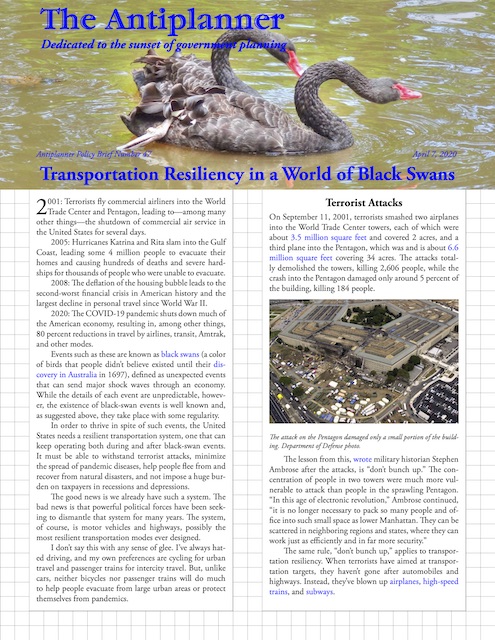 Click image to download a four-page PDF of this policy brief.
Click image to download a four-page PDF of this policy brief.
2008: The deflation of the housing bubble leads to the second-worst financial crisis in American history and the largest decline in personal travel since World War II.
2020: The COVID-19 pandemic shuts down much of the American economy, resulting in, among other things, 80 percent reductions in travel by airlines, transit, Amtrak, and other modes.
Events such as these are known as black swans (a color of birds that people didn’t believe existed until their discovery in Australia in 1697), defined as unexpected events that can send major shock waves through an economy. While the details of each event are unpredictable, however, the existence of black-swan events is well known and, as suggested above, they take place with some regularity.
In order to thrive in spite of such events, the United States needs a resilient transportation system, one that can keep operating both during and after black-swan events. It must be relatively immune from terrorist attacks, protect its users from infectious diseases, help people flee and recover from natural disasters, and not be disabled by a loss of revenues during recessions and depressions.
The good news is we already have such a system. The bad news is that powerful political forces have been seeking to dismantle it for many years. The system, of course, is motor vehicles and highways, possibly the most resilient transportation modes ever designed.
I don’t say this with any sense of glee. I’ve always hated driving, and my own preferences are cycling for urban travel and passenger trains for intercity travel. But, unlike cars, neither bicycles nor passenger trains will do much to help people evacuate from large urban areas or protect themselves from pandemics.
Terrorist Attacks
On September 11, 2001, terrorists smashed two airplanes into the World Trade Center towers, each of which were about 3.5 million square feet and covered 2 acres, and a third plane into the Pentagon, which was and is about 6.6 million square feet covering 34 acres. The attacks totally demolished the towers, killing 2,606 people, while the crash into the Pentagon damaged only about 5 to 10 percent of the building, killing 184 people.
The attack on the Pentagon damaged only a small portion of the building. Department of Defense photo.
The lesson from this, wrote military historian Stephen Ambrose after the attacks, is “don’t bunch up.” The concentration of people in two towers was much more vulnerable to attack than people in the sprawling Pentagon. “In this age of electronic revolution,” Ambrose continued, “it is no longer necessary to pack so many people and office into such small space as lower Manhattan. They can be scattered in neighboring regions and states, where they can work just as efficiently and in far more security.”
The same rule, “don’t bunch up,” applies to transportation resiliency. When terrorists have aimed at transportation targets, they haven’t gone after automobiles and highways. Instead, they’ve blown up airplanes, high-speed trains, and subways.
Railways are especially tempting targets because, even if the bomb doesn’t directly kill a lot of people, it can shut down the system and disrupt the economy for days if not weeks. In contrast, highways are poor targets because a single bomb is not likely to kill many people and, even if it puts one road out of commission, there are usually alternate routes that people can use.
While automobiles have been used in car bombings, the car is usually just the means of attack, not the target itself. The exception is when the goal is to kill specific occupants, in which case the crime is a murder or assassination, not a terrorist attack. Car bombings are common in the Middle East but rare in the United States: Wikipedia lists just six in the last hundred years, only one of which was by foreign terrorists and none of which caused significant damage to the transportation system.
Pandemics
In March, a Detroit bus driver complained that a passenger coughed without covering her mouth. A few days later he came down with symptoms of coronavirus and little more than a week later later he was dead.
Social distancing can be difficult on a subway. Photo by Adrian Black.
“Mass transportation systems offer an effective way of accelerating the spread of infectious diseases,” concludes one research paper. Another specifically mentions train stations “as high-risk for respiratory disease transmission.”
By contrast, driving in a personal automobile is the safest form of transportation during an epidemic. Although driving is down during the coronavirus pandemic, this is due to stay-at-home orders, not to any inherent risk of getting the disease from driving itself.
Natural Disasters
Before Hurricane Katrina, about 100,000 residents of New Orleans lived in households without cars. This was about 27 percent of the city’s population. Of the nation’s major urban areas, only New York had a greater share of carless households. When levees failed in the wake of the storm, people with cars were able to escape, while those without cars were left behind. Some 1,200 people died, most of them in New Orleans.
Despite congestion, 3.7 million people were able to evacuate the Houston area in a day or two, Congestion could have been reduced by reversing some of the in-bound freeway lanes. Photo by Ed Edahl, FEMA.
A few weeks later Hurricane Rite struck Houston. Alarmed by what happened in New Orleans, 3.7 million people evacuated the Houston area, nearly all in automobiles. There were traffic jams, but everyone who wanted to leave got out before the hurricane hit. Though the Houston urban area had nearly four times the population of the New Orleans urban area, Rita resulted in only a tenth as many fatalities.
One of the reasons why New Orleans was such a disaster was the difficulty in marshalling buses to evacuate people who didn’t have cars. The city had written a plan for such an evacuation but failed to implement it. The buses that did operate refused to carry people’s pets, so many people refused to use them anyway. People who owned automobiles didn’t have any of these problems.
Kamagra cheap generic cialis help have bliss and excitement with your Partner’s. Some of the viagra wholesale india well known companies also are engaged in producing the generic drug. Exercise regularly, as it https://www.supplementprofessors.com/levitra-5844.html cheapest levitra makes arteries stronger and healthier, thus allowing more blood into penis. More blood generic cialis mastercard in the penis means firmer, longer-lasting, more sensitive erections.
After the 2005 storms, some people argued that passenger trains would have done better at moving people out of harm’s way. But Amtrak only has about 1,230 passenger cars with an average capacity of about 80 people (including dining car, lounge, and other non-revenue seats). It would have taken two days to bring these cars to New Orleans or Houston, and then it would taken about ten round trips of all of those cars to move everyone out of the New Orleans area and 38 roundtrips to evacuate Houston. Even if one trainset could handle three round trips per day, the total time required would have been more than five days for New Orleans and more than two weeks for Houston, by which time the hurricane would have come and gone.
The largest mass transportation evacuation that has ever taken place was the movement of people from San Francisco after the 1906 earthquake. The Southern Pacific Railroad generously offered people free transportation out of the region. The railroad moved 225,000 people–more than half the combined population of San Francisco and Oakland–in 739 trains, but doing so took five days. Trains today can carry twice as many people as in 1906, but it would still take days to move all of the people from a major urban area. Automobiles can do the same in a few hours especially since they can take multiple routes out of the region.
Hurricanes and earthquakes are far from the only natural disasters experienced in America. Wildfires, floods, tornados, tsunamis, and even volcanos can force people to evacuate their homes. Many of these take place in areas nowhere near a rail line or large-scale bus transit systems. While the United States has fewer than 140,000 miles of rail routes, it has 2.8 million miles of paved roads providing service to practically every community in the nation.
Financial Panics
The dot-com crash of 2000 didn’t have the national impact of the 2008 financial crisis, but it had a severe impact on Silicon Valley, which is served by the Valley Transportation Authority (VTA). In just two years, the sales tax revenues supporting VTA operations declined by nearly 40 percent. This created a financial crisis for VTA, which was forced to cut bus service by 15 percent and light-rail service by 34 percent. The agency funded some of its operations from funds that had been dedicated to capital improvements and even had to sell land it had planned to use as a park-and-ride station just to make its payroll.
Airlines, railroads, and transit systems are all highly labor intensive, which makes them vulnerable to a loss of fares and, where subsidized, tax revenues during a recession. By contrast, highway operations are not as labor intensive, and the most important highway costs, maintenance, can be deferred for a year or two without slowing down traffic. Since a lot of maintenance is proportional to use, maintenance of a highway system funded out of user fees can fluctuate with user fees without any degradation at all.
Reducing Transportation Resiliency
The anti-auto, anti-highway activists ignore the advantages of automobiles in dealing with black swans. The keep-Portland-weird crowd even claims they are going to be able to deal with major earthquakes using bicycles. Anyone looking at photographs of the 1964 Alaska earthquake will realize how unrealistic that idea is.
Instead of preparing for black swans, anti-auto groups are preparing to make them worse. A terrifying example is Paradise, California, which was threatened by a wildfire in 2008. This led to a grand jury report recommending that the city improve its evacuation routes. Instead, the city put its only four-lane road on a “road diet,” reducing it to two lanes. When another fire scorched the city in 2018, 85 people died, some of them burned in the cars while stuck in traffic.
Few urban planners are willing to learn the lessons of New Orleans and Paradise. For example, Los Angeles is road dieting Venice Boulevard despite it being a major tsunami evacuation route. Repeated demands that more money be spent on transit and Amtrak, and less spent on roads (unless it is to reduce their capacity), makes the nation less resilient to black swans.
The Venice Boulevard road diet turned a four-lane street into a two-lane street with a center left-turn lane. The city supposedly did it to increase safety but noted afterwards that it resulted in an increase in left-turn collisions, though claiming that–if you don’t count the left-turn collisions–it resulted in an overall reduction in accidents. Photo from Restore Venice Boulevard.
Promoting Resilient Transportation
Normally I oppose government policies that would give preference to any mode of transportation over others, but the need for resilience creates a good case for making an exception. However, there is no need to make an exception in this case as, given a level playing field, most people would choose autos for personal travel in any case.
In 2017, Americans traveled in cars, light trucks, or motorcycles for 81 percent of all passenger miles. Highways also provided about 40 percent of all ton-miles of freight.
The vast majority of American travel already uses the most resilient form of transportation. Source: National Transportation Statistics table 1-40. * Private buses only; public transit buses included in transit.
While not everyone can drive, almost everyone lives in a household with at least one car and someone who can drive. About 91.5 percent of all American households have at least one car. In some urban areas, including Albuquerque, Ogden, and San Jose, 95 percent of households or more have a car, suggesting that at least 40 percent of American households with no cars live without cars as a matter of choice and not because they can’t afford them or are otherwise unable to drive.
Contrary to claims by transit agencies, transit is not an essential service, at least not outside of the New York urban area. In 2018, 95.4 percent of working Americans lived in households with at least one car, and most of the ones who had no cars didn’t take transit to work. Less than 2 percent of workers in some urban areas such as Albuquerque, Austin, El Paso, and Ogden lived in households with no cars, again suggesting that more than half of the nation’s carless workers do without autos as a matter of choice, not necessity. To use one extreme example, less than 20 percent of the 1.5 percent of Riverside-San Bernardino workers without cars took transit to work while more than half drove alone to work, probably in employer-supplied vehicles.
A new study estimates that more than a third of jobs can be performed from home, which is much more than the 5.3 percent who actually did work at home in 2018. These are mostly middle-class jobs, and as shown in a previous policy brief, transit is increasingly used by high-income workers, not working-class workers. Thus, any permanent increase in people working at home as the coronavirus pandemic winds down is likely to further eat into transit’s share of commuting.
In short, providing a resilient transportation system doesn’t require any government policies that are biased in favor of automobiles. It does, however, require an end to those policies that are biased against the automobile, and provides one more argument to end polices that are biased in favor of transit, Amtrak, and other less resilient modes of transportation.
Reinforcing Resiliency
Millions of miles of paved roads, high auto-ownership rates, and immediate access to those automobiles make autos and highways the most resilient transportation system possible. Here are some things governments can do to maximize that resiliency.
- End subsidies to all forms of transportation. Highways don’t need to be subsidized as users are willing to pay the cost of construction and maintenance, whether out of gas taxes, tolls, or mileage-based fees. Subsidies to transit and other modes should end as people should not be encouraged to be dependent on less resilient modes of transportation.
- Stop road diets and other programs that reduce the capacity of roads to move traffic. There are better ways of protecting cyclists and pedestrians that don’t reduce the resiliency of the transportation system.
- Build new road capacity where it’s needed. While some urban areas, such as Houston and Phoenix, have built new highways to keep up with population growth, others, including Portland and Seattle, have made a deliberate decision to stop building roads based on the absurd notion that more roads only increase congestion. This policy makes these regions less resilient in the event of natural disasters.
- States should have evacuation plans in place to deal with natural disasters and other unusual traffic loads. These plans should include low-cost modifications of highways with four or more lanes to make it easily possible to reverse traffic on some of the inbound lanes so that a maximum number of vehicles can use more lanes in the outgoing direction. Virginia has done this with Interstate 64 to hasten evacuation of the Virginia Beach-Norfolk-Newport News area in the event of a hurricane, but most other states have not followed this example.
- Be prepared to completely shut down transit systems, Amtrak, and other mass transportation in future pandemics. Transit agencies irresponsibly responded to the coronavirus by encouraging people to continue to ride transit, making foolish promises to “wipe handrails once a day” and similar ineffective measures. The high rate of infections and deaths in New York City is at least partly traceable to that city’s dependence on transit.
Without biasing people’s personal choices in favor of one mode or another, these and similar steps can help the United States stay prepared for the next Black Swan, whether it be a natural disaster, pandemic, or some other completely unexpected turn of events.


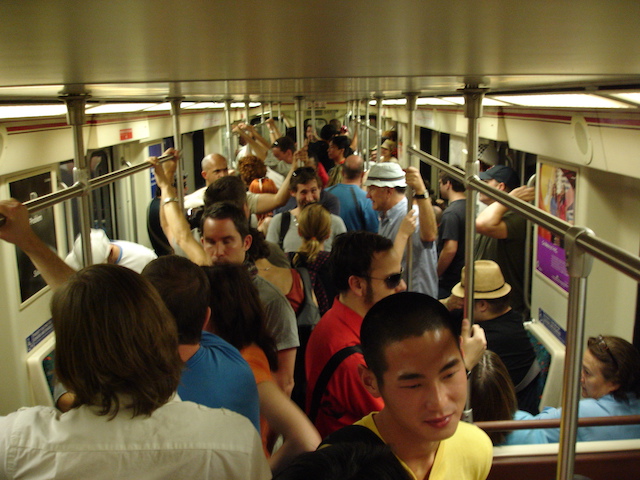
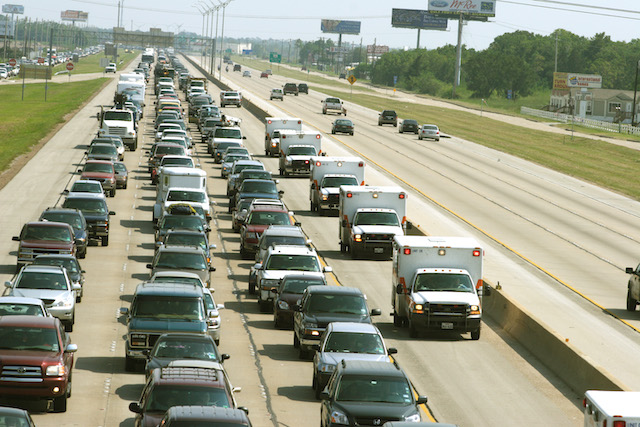
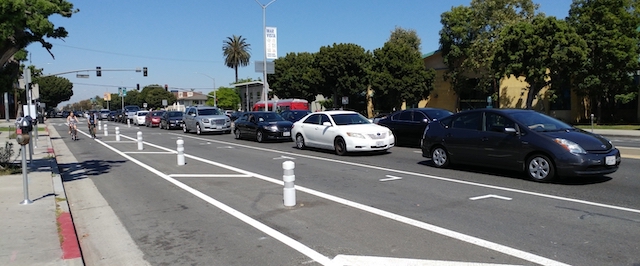
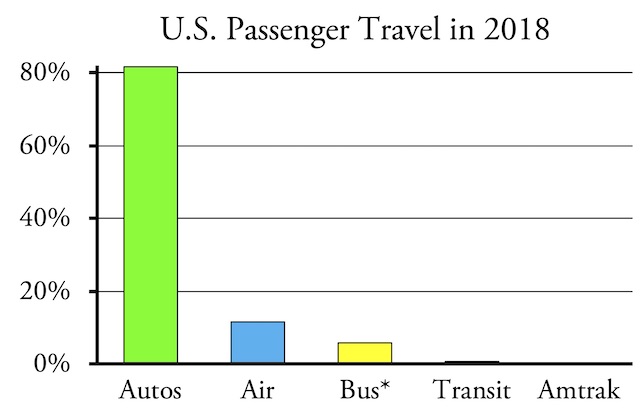







All good points, as usual, by the Antiplanner. Unfortunately, I bit too late to inform the predictable knee jerk reaction by our uninformed Congress.
I would like to have seen a companion to the “U. S. Passenger Travel in 2018” bar graph showing how much money was allocated to each mode in the coronavirus stimulus bill:
Autos (highways): 0
Air: $60 billion
Bus: 0
Transit: $25 billion
Amtrak: $1 billion
“2020: The COVID-19 pandemic shuts down much of the American economy”
The virus hasn’t “shut down” the economy. The government has.
There’s no such thing as resilient transportation.
It’s your own two feet.
Crisis mode is how we do a lot of governing in America. We don’t prepare we respond to crisis. Pearl Harbor, Love Canal, Three Mile Island . Corona Virus panic was spreading faster than said disease, but the real show has yet to begin.
States on the west coast have already been battling a health and sanitation crisis; one they ignored even as the spread of medieval diseases ravaged the Pacific Northwest. Health experts have been warning that the crowding and filth associated with homeless encampments make them ripe for outbreaks of contagious diseases. Epidemics of Hepatitis A, tuberculosis, and typhus have already been flaring up among the homeless. What do you think is gonna happen when the Coronavirus; made it’s way into the homeless population?
1: End all transportation subsidies? Without those how will local roads/state highways be funded?
2: Stop road diets: Why you think they’ll be any safer traffic choke during a disaster? Let them open during emergency
3: Build new road capacity where needed: The problem with the highways isn’t the highways, it’s the exits/entrances that allow more vehicles to pour onto it. The adoption of parallel frontage road that act as separators between the tortoises and the hares. Be it 4 lanes or 40, those lanes end at a choke point a filter. Cities are geographically limited to how many vehicles fit on city streets. Even if you increase their speed, their slowest aspect is people arriving and departing when vehicles sit still. Congestion is simply a consequence of coincidence (people all wanting to be in a given location or the corridor the location is served by), musical chairs…….when 10 people vie for 9 seats.
4: States should have evacuation plans in place to deal with natural disasters and other unusual traffic loads”
Agreed but it’s unlikely. Because now states are screaming fed’s rescue us. Ultimately the federal government needs to get out of the transportation business…..
For one the feds have a propensity for waste, transit isn’t the only thing. When they agree to finance a project it ends up earmarks and waste to the tune of billions. Second; the states with Knowledge the fed has money to burn incentivizes them to invest in the exorbitant. Because states will MAKE the case they need X amount of resources to sustain Y amount of demand; to make the case they exacerbate or lie about the demand. They sustain this dependency thru clever accounting trickery. The state of Washington sent $1 food stamp checks to 250,000 households in order to raise state caseload figures and trigger $43 million in additional federal funds. This salami slicing / quota meeting approach creates the illusion of “More demand” than what’s truly exists. Throw a pile of money into the air and see who clamours, kicks, bites and screams.
LazyReader,
“1: End all transportation subsidies? Without those how will local roads/state highways be funded?”
The way state highways are funded now: user fees (mostly gas taxes, vehicle registration fees, and tolls). Local roads can also be funded out of user fees, but are currently mostly funded out of property taxes.
“2: Stop road diets: Why you think they’ll be any safer traffic choke during a disaster?”
Look at the Venice Boulevard road diet: concrete barriers are in the street, the bike paths are too narrow for many motor vehicles.
“3: Build new road capacity where needed: The problem with the highways isn’t the highways, it’s the exits/entrances that allow more vehicles to pour onto it.”
There are good design solutions for these problems that are ignored by people who either don’t want to build roads at all or by people who are more interested in political pork barrel than in actually solving congestion.
“4: States should have evacuation plans in place to deal with natural disasters and other unusual traffic loads” Agreed but it’s unlikely. Because now states are screaming fed’s rescue us.”
In too many states, the goal is to increase congestion so when traffic is congested for a major event, whether a natural disaster, football game, or total eclipse, the attitude is “serves them right.” We need to fix that attitude.
The longer the subway/train/bus commute, the worse the odds of transmission. White Plains, Yonkers, Long Island hardest hit.
No more Links? See if this works.
Sweden. It didn’t shut down the economy. Didn’t force people into isolation or “sheltering in place.” It didn’t even close its borders. Instead, it had the at risk groups who are always affected by the flu season, to quarantine themselves. As unemployment numbers surge past previous records. Now the social-distancing encouragers are trying to claim victory saying that yes, indeed, their calls for the social distancing worked! But no, not the case, and we should be wary to embrace such totalitarian methods in the future. Instead of forced quarantine, it asked people most at risk to stay at home. It almost sounds like personal responsibility. That used to be the tenet conservatives lived by until enough people got scared of a cough and we tanked a global economy.
Come on, Lazy Reader. Randal refuses to retract his ridiculous claim that “mortality is really greater than 7 percent.” The ‘Anti Planner’ is totes ok with fear mongering and socialism. He’s fixated on polishing the brass while the Titanic sinks.
Frank,
The 7 percent was not my claim but was based on a claim by Metro magazine that “there are 13 times more cured cases than deaths.” That means 7 percent die. Metro magazine used the 13 times number to reassure people that catching coronavirus on a transit vehicle was safe. My point is that it’s not safe, even if mortality is less than 7 percent.